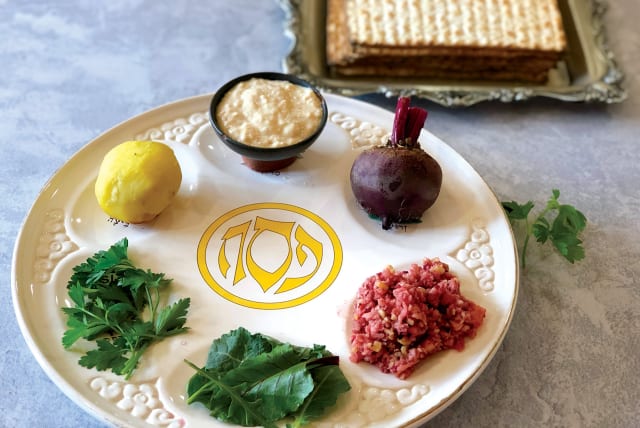The paradox of the Pesach symbols - opinion

Our challenge for this Passover is not to lose sight of either, making space for both our heartbreak and our hope, praying that it won’t be long before we “sing a new song upon our salvation."
In just a matter of days, we will all sit at the festive Seder table, in commemoration and celebration of the foundational story of our people. We will read the Haggadah, our guidebook through the evening, as we tell our story with the help of the various symbolic foods that grace the Seder table.
And yet, this year the joy of the holiday will be colored with grief, sorrow, and anxiety. There are so many empty chairs at so many Seders – some for reservists back on the frontlines, some for the remaining hostages, some for those who remain in hospital for their injuries or in hotels as their displacement continues, and yet more for all whose lives have been taken from us on and since October 7.
The weight grew even heavier last weekend, as Iranian cruise missiles and drones rained down on our cities, striking fear into the hearts of Israelis across the country. This latest escalation in Iran’s campaign to destroy our nation threatens our very existence and instills even greater anguish in the minds of our already overburdened children.
How are we meant to focus on the festival’s messages of freedom, peoplehood, and redemption in the face of the overwhelmingly tragic and terrifying events of the last six months?
The symbols of Passover hold the answer
Perhaps the answer lies in the duality of the Seder’s narrative and of its symbols themselves.
In order to fulfill the mitzva of sippur yetziat Mitzrayim, of telling the story of our release from bondage in Egypt, we must begin our retelling by recounting the servitude itself, and only then make our way towards redemption.
This framing, making space for both the servitude and the redemption, plays out in the symbolic items on the Seder table as well.
The matza we eat is presented twice in maggid (“recounting”) – first in the ha lachma anya (“the bread of affliction”), seeing in the matza the bread of affliction eaten while our ancestors were enslaved in Egypt, and then again at the closing of the maggid section, where the matza celebrates redemption, reminding us of the hurried departure from Egypt, which left the Jews with no time to allow their dough to rise.
The same goes for the maror, the bitter herbs. The Mishna (Pesachim 10:5), cited in the Haggadah, attributes the maror to the bitterness of slavery (Shemot 1:14), yet Rav Chaim ibn Attar, in his masterful commentary Or Hachayim (Shemot 12:8), sees maror as a way to accentuate the taste of the korban Pesach (“Passover sacrifice”) eaten with it.
Even the maror has a dual purpose, focusing on both dimensions of Passover: the enslavement and the redemption.
SO, TOO, for the four cups of wine. On the one hand, they are traditionally associated with the four redemptions from Egypt (Shemot 6:6-7; Yerushalmi Pesachim 10:1). On the other hand, the Shulchan Arukh (Orach Chayim 472:11) notes a preference for red wine for it recalls the blood of the Jewish children spilled by Pharaoh as he had them cast into the Nile.
Even the sweet haroset, according to Gemara Pesachim (116a) holds within it a duality of meaning, directing our memory both to the fragrant apple orchards, in which Jewish women would secretly birth their children, and to the thick mortar the Jewish slaves would prepare and use during their backbreaking labor.
Each one of these symbols has two layers of meaning, one of genut and avdut (“denigration” and “slavery”) and one of shevach/geula (praise and redemption). Yet unlike the telling of the story, which follows a clear chronological trajectory, the symbols on our Seder table are denied the luxury of beginning with sadness and journeying into joy.
On the contrary, our matza, maror, wine, and haroset are left to hold the whole story together – simultaneously the tragedy and the relief, all the pain and all the healing, all the grief and all the hope – in a single instant.
This intermixing of suffering and redemption speaks to us so clearly this year. We will celebrate our people, our state, and our bright future, without losing sight of all that remains broken: the empty chairs, the unbearable sacrifices, and the ongoing challenges facing our people. We will bring all this grief with us into Passover this year, as we reminisce about marching out of Egypt and dream ahead to our ultimate redemption.
These feelings are not in opposition to one another, but complementary – the story of our people, throughout history and in this moment, holds within it both of these poles.
We are at the same time a redeemed people and a people in a state of challenge, with both Eliyahu the prophet and the angel of destruction simultaneously knocking on our door on Seder night. For this is the Jewish dance toward eternity.
Our challenge for this Passover is not to lose sight of either, making space for both our heartbreak and our hope, praying that it won’t be long before we “sing a new song upon our salvation, and upon the redemption of our souls.” (Haggadah).
The writer, a rabbi, is president and rosh yeshiva of Ohr Torah Stone, a Modern Orthodox network of 32 educational and social institutions and programs transforming Jewish life, learning and leadership worldwide.
Jerusalem Post Store
`; document.getElementById("linkPremium").innerHTML = cont; var divWithLink = document.getElementById("premium-link"); if (divWithLink !== null && divWithLink !== 'undefined') { divWithLink.style.border = "solid 1px #cb0f3e"; divWithLink.style.textAlign = "center"; divWithLink.style.marginBottom = "15px"; divWithLink.style.marginTop = "15px"; divWithLink.style.width = "100%"; divWithLink.style.backgroundColor = "#122952"; divWithLink.style.color = "#ffffff"; divWithLink.style.lineHeight = "1.5"; } } (function (v, i) { });

